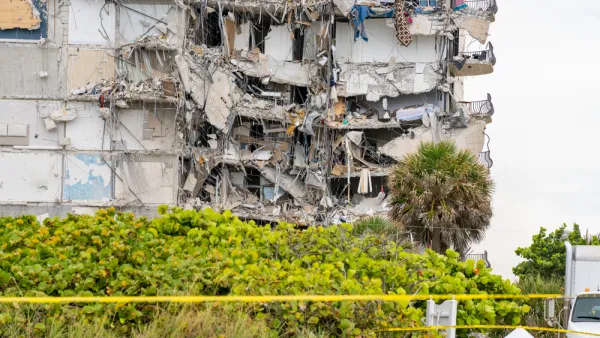A coastal geologist urges state leaders and residents to start planning for 'managed retreat' away from the coastal communities most vulnerable to sea level rise.

While climate change may not be directly related to the partial collapse in June of a condo building in Surfside, Florida, "the collapse has shone a spotlight on Florida’s unique vulnerabilities to climate change and raised questions about whether the state’s coastal infrastructure is equipped to handle the flooding that comes with sea-level rise." Zoya Teirstein interviews Randall W. Parkinson, a coastal geologist at Florida International University in Miami, who "thinks it’s already time to start thinking about moving residents away from the sea."
"By 2050," says Parkinson, "buildings in South Florida may be inundated by 2 to 3 feet of sea-level rise, plus 4 or more feet of storm surge." To him, "the collapse was a bellwether moment or a tipping point in the conversation, where for the first time, many more people are thinking more seriously about climate change in the coastal zone." Despite a reluctance on the part of most Floridians to consider managed retreat, Parkinson says the conversation is more essential than ever. "[T]hese current plans, they might hold the line for the next 30 years or so, but it’s just going to be untenable after that. And people are going to have to begin to make plans for how to withdraw and to ensure equity in the transition."
"Preventing future tragedies means acting now," Parkinson says. Otherwise, state and local leaders risk "having to make that decision when you have a major catastrophe." Floridians now face a critical decision: "You do nothing, you adapt (which is a temporary fix because eventually these low-lying coastal areas are all going to be underwater), or, at some point, people are going to have to think about a managed withdrawal from the coastline. Right now, it wouldn’t be managed; it would be total chaos."
FULL STORY: The Surfside tragedy could be a ‘bellwether moment’ for managed retreat

National Parks Layoffs Will Cause Communities to Lose Billions
Thousands of essential park workers were laid off this week, just before the busy spring break season.

Retro-silient?: America’s First “Eco-burb,” The Woodlands Turns 50
A master-planned community north of Houston offers lessons on green infrastructure and resilient design, but falls short of its founder’s lofty affordability and walkability goals.

Delivering for America Plan Will Downgrade Mail Service in at Least 49.5 Percent of Zip Codes
Republican and Democrat lawmakers criticize the plan for its disproportionate negative impact on rural communities.

Test News Post 1
This is a summary

Test News Headline 46
Test for the image on the front page.

Balancing Bombs and Butterflies: How the National Guard Protects a Rare Species
The National Guard at Fort Indiantown Gap uses GIS technology and land management strategies to balance military training with conservation efforts, ensuring the survival of the rare eastern regal fritillary butterfly.
Urban Design for Planners 1: Software Tools
This six-course series explores essential urban design concepts using open source software and equips planners with the tools they need to participate fully in the urban design process.
Planning for Universal Design
Learn the tools for implementing Universal Design in planning regulations.
EMC Planning Group, Inc.
Planetizen
Planetizen
Mpact (formerly Rail~Volution)
Great Falls Development Authority, Inc.
HUDs Office of Policy Development and Research
NYU Wagner Graduate School of Public Service




























